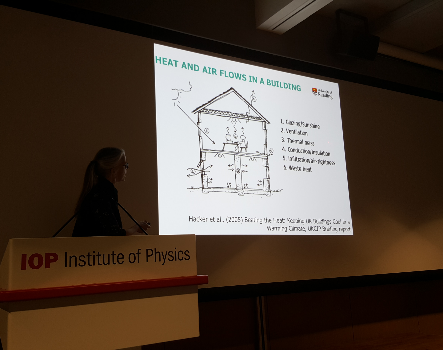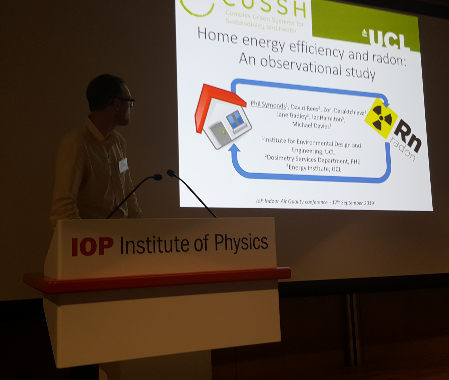Indoor Air Quality
ECG Bulletin January 2020
The RSC Environmental Chemistry and Toxicology Groups joined forces with the Environmental Physics Group from the Institute of Physics (IoP) to organise a one-day meeting on indoor air quality on 17th September. 35 delegates convened in the IoP’s new flagship building in London to hear about the latest findings in indoor air chemistry and physics and discuss the challenges ahead.
The first speaker was Dr Ben Barratt from King’s College London, who presented a fascinating introduction on the links between indoor and outdoor air. Ben shared findings from various studies, including one comparing nitrogen dioxide (NO2) measurements from background monitoring stations, sensors installed outside and inside homes, and portable devices for personal exposure. The results clearly indicated that the usual demarcation between outdoor and indoor air quality becomes increasingly blurry when personal exposure is taken into account, with overall exposure consisting of a mixture between the two. Ben also presented the preliminary results from another study in which portable particulate (PM2.5) monitors were attached to backpacks worn by school children in London to determine during which part of the day children were exposed to the most pollution. Initial results show clear spikes during their commute to and from school (outdoor), but also in the evening as a result of cooking (indoor). The highest concentrations of PM2.5 were found on the London Underground and when someone was smoking or cooking indoors (~350 μg/m3). In comparison, concentrations on a busy high street were much lower (~50 μg/m3), yet these are the only emissions that current pollution curbing measures are addressing.
|
Professor Janet Barlow from the University of Reading spoke next on the topic of natural ventilation processes in urban buildings. This is particularly timely in the context of buildings becoming increasingly airtight in attempts to be more energy efficient – typically one third of heat is lost through air leakage. Professor Barlow introduced the main drivers of indoor ventilation (pressure and heat) and the other physical factors that affect it, including room layouts, wind speed and direction, glazing and sunshine, thermal mass, and human behaviour. In particular, she focused on an infiltration study carried out in an old office block on Marylebone Road, which used a number of sensors deployed in different locations (outdoors, indoors and in an internal courtyard) to characterise the rates of infiltration and its main drivers. She also discussed the REFRESH project, investigating the interactions between the built environment and its occupants. In particular, the project highlighted the poor management of indoor environmental conditions. Janet suggested that a clearly visible traffic light system (e.g. a wall clock) for a specific indoor pollutant could be used in shared indoor environments (e.g. offices) so that all occupants could be made aware of when to take remedial action such as opening a window.
|
The first afternoon session was devoted to modelling and measurements of indoor air chemistry with talks from Dr Nicola Carslaw (University of York) and Dr Coralie Schoemaecker (University of Lille). Dr Carslaw introduced the main concepts of indoor air chemistry, stressing how the chemical regimes of these environments can be very different from those found outdoors, in particular with respect to the type and abundance of species and to the physical conditions (light, humidity, etc.). As a result, whilst most of outdoor atmospheric chemistry is initiated by the photochemical formation and reactivity of the hydroxyl radical (OH), indoor air chemistry is initiated by the reaction of ozone with volatile organic compounds (VOCs). While outdoor air can affect indoor air via infiltration, the main sources of indoor air pollution are cooking and cleaning activities. In particular, the VOCs released by most commercial cleaning products (e.g. limonene, linalool and α-pinene), once oxidised by ozone, can form a number of secondary and tertiary products, some of which are harmful to health. As many key indoor chemical species are challenging to measure, models such as the Indoor Detailed Chemical Model (INDCM) are often the best tools for providing insight into the complex chemistry of indoor environments. Dr Carslaw also discussed the importance of indoor photolysis and, in particular, the use of UV lamps for extreme cleaning in hospitals to fight the spread of bacterial infections. Studies show that these lamps lead to high concentrations of OH radicals and, consequently, of highly oxidised (and potentially harmful) reaction products. This begs the question of whether or not we are creating a supplementary health issue. Dr Shoemaecker focused on the measurement aspects of indoor air chemistry, describing the various techniques used in field campaigns in indoor environments such as schools. Monitoring indoor VOCs by thermal desorption tubes has revealed that up to 60% of VOCs are emitted by the occupants in a lecture room. Squalene in particular, a polyunsaturated hydrocarbon, is naturally shed from human skin and readily reacts with ozone to form semi-volatile products that can be irritants. In addition, the increased surface-to-volume ratio found in an indoor environment means that surfaces can significantly influence the chemistry, as both sources and sinks of airborne species. Field studies have found that furniture, glued flooring and painted walls act as sources of trace species, notably formaldehyde and other VOCs. Comparison of observed concentrations with models such as INDCM have highlighted areas of uncertainty that are in need of further characterisation in indoor environments, such as surface uptake and deposition and photolysis processes driven not just by transmitted external light, but also by some types of artificial lighting (e.g. uncovered fluorescent bulbs).
The third and final session of the day started with Professor Benjamin Jones from the University of Nottingham, who focused on the relationship between building ventilation, indoor air quality and occupants’ health. Following a retrospective on indoor ventilation through the ages including an explanation of how the ancient Egyptians built air shafts within the Great Pyramids, Ben focused on how to optimise ventilation rates for a large variety of building types. As it is difficult and time-consuming to measure the ventilation rate for every specific indoor environment (such as each classroom in a school), we are moving away from a fixed recommended value (or range of values) for ventilation rate (7.5-10 Ls−1) towards a more dynamic approach in which a proxy variable (such as CO2 concentration) is monitored and the ventilation rate adjusted so that the proxy does not exceed a particular threshold. The final part of the talk focused on a novel statistical approach aimed at selectively targeting specific indoor pollutants to maximise the health and economic benefits of good indoor air quality. This method identified particulate matter, formaldehyde and acrolein as the main priorities to improve indoor air.
|
The last talk of the day was given by Dr Phil Symonds from University College London (UCL), who focused on radon gas in indoor environments. Radon is formed from the radioactive decay of uranium contained in a number of geological formations around the globe, and can seep into buildings from cracks in the foundations or flooring. Radon occurrence is higher in particular regions (Cornwall, for example), depending on the local geology. Radon itself is radioactive, and exposure to it is the second leading cause of lung cancer worldwide after smoking. Dr Symonds showed the results of the analysis of a large dataset consisting of radon measurements made in 470,689 UK homes between 1980 and 2015. This study found that energy efficiency measures tend to increase the airtightness of properties and thus have an adverse effect on indoor radon levels. For instance, homes with double glazing installed had radon levels up to 67% higher than those without. This study highlighted how the push to improve the energy performance of the UK's housing stock must not compromise indoor air quality.
|
Appropriately, the meeting was hosted in the new IoP building, which was designed with sustainability in mind. It features ground source heat pipes, solar panels and a green roof, together with a huge screen containing footage of the Moon’s surface and a cloud chamber.



